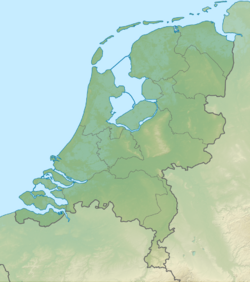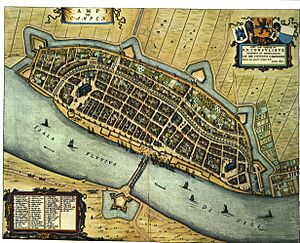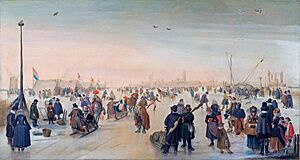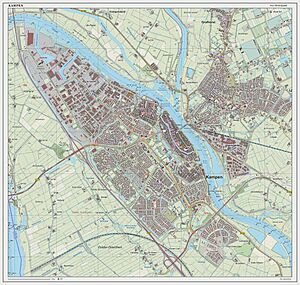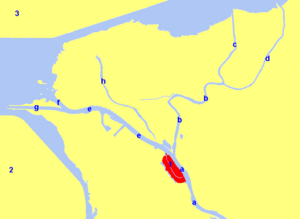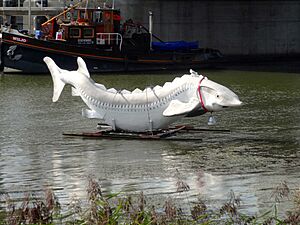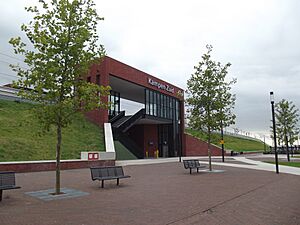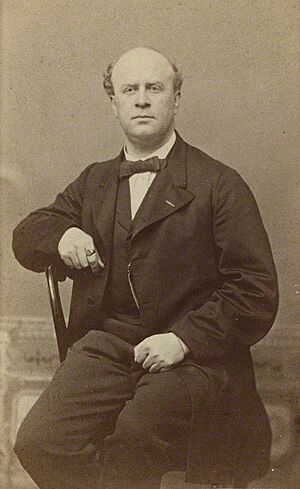Kampen, Overijssel facts for kids
Quick facts for kids
Kampen
|
|||
|---|---|---|---|
|
City and municipality
|
|||

Kampen city centre with the Bovenkerk in the middle of the picture
|
|||
|
|||
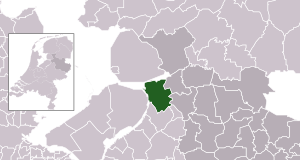
Location in Overijssel
|
|||
| Country | Netherlands | ||
| Province | Overijssel | ||
| City Hall | Kampen City Hall | ||
| Government | |||
| • Body | Municipal council | ||
| Area | |||
| • Total | 161.79 km2 (62.47 sq mi) | ||
| • Land | 142.64 km2 (55.07 sq mi) | ||
| • Water | 19.15 km2 (7.39 sq mi) | ||
| Elevation | 1 m (3 ft) | ||
| Population
(May 2014)
|
|||
| • Total | 51,278 | ||
| • Density | 359/km2 (930/sq mi) | ||
| Demonym(s) | Kampenaar | ||
| Time zone | UTC+1 (CET) | ||
| • Summer (DST) | UTC+2 (CEST) | ||
| Postcode |
8260–8279
|
||
| Area code | 038 | ||
Kampen is a city and a municipality in the Overijssel province of the Netherlands. It's located where the IJssel river flows into a larger body of water. Kampen was once an important member of the Hanseatic League, a powerful group of trading cities in Northern Europe.
The municipality of Kampen had about 51,278 people in 2014. It covers an area of about 161.79 square kilometres (62.47 square miles). Kampen is in the northwest part of Overijssel. The city of Kampen itself has around 37,000 residents.
Kampen has one of the best-preserved old town centers in the Netherlands. You can still see parts of its old city wall. Three of its ancient city gates are still standing. There are also many old churches. Three bridges cross the IJssel river, connecting Kampen to IJsselmuiden and Kampereiland. Kampereiland is a farming area in the river's delta. The city also has a windmill called d' Olde Zwarver, which means 'the Old Vagabond'. Since 2018, the town and some areas are on a river island. From the 14th to the 16th century, Kampen was one of the biggest towns in the northern Netherlands. It is about 90 kilometers northeast of Amsterdam.
People in Kampen traditionally speak a local dialect called Kampers. It's a type of Sallands dialect.
History of Kampen
Early Beginnings
By the year 1150, there were already wooden buildings where Kampen is today. However, the name Kampen wasn't used until 1277. The city received its official "city rights" in 1236. This meant it could govern itself and hold markets.
Kampen was in a great spot for trade. It was on a busy route between the Zuiderzee (a former bay) and the Rhine river. Because of this, Kampen quickly grew from a small settlement into a rich trading town. It became one of the most powerful cities in northwestern Europe. In the 14th century, Kampen made a deal with the bishop of Utrecht. It traded some land to get the right to expand the IJssel river delta.
Joining the Hanseatic League
Around 1430, the IJssel river started to get shallower. This made it harder for big ships to reach Kampen. This slowly ended the city's great wealth. For a long time, Kampen didn't want to join the Hanseatic League. This group of cities usually made trade deals and shared power.
When the County of Holland went to war with the Hanseatic League, Kampen had to pick a side. Kampen had strong ties to trade in the Baltic Sea and with the Rhine region. So, in 1441, it officially joined the Hanseatic League. Kampen had a lot of influence in the League. In 1448, the League agreed to build a bridge over the IJssel river. This was done in just five months, even though other towns protested. Kampen hoped this bridge would help it trade more easily with the inland areas.
Later Years and Changes
On August 11, 1572, Willem van den Bergh, a brother of William the Silent, took Kampen from the Spanish. But after a terrible event in Zutphen on November 15, the city gave up to the Spanish on its own. In 1578, the city changed hands again after a Siege led by George van Lalaing.
Because Kampen had the right to expand the IJssel delta, it owned the growing Kampereiland. From 1500, these islands were rented out. The money from these rents was so large that the city didn't need to collect taxes from its people.
In 1670, Kampen was the first of four Dutch cities to raise money by using a special investment plan called a Tontine.
The Franco-Dutch War marked the end of the city's great power. This war was fought by the Dutch Republic against France, Sweden, and other countries.
Kampen became well-known again in the 19th century. It was hard for ships to reach the city from the sea because the surrounding wetlands were getting shallower. The IJssel river was dredged many times over the centuries. But this was expensive, and the river would quickly become shallow again. In the 19th century, a new plan was made. Some smaller water channels were blocked off. This made more water flow faster through one or two main routes. This helped the river clean itself, so less sand and mud built up. A key person in this effort was city architect Nicolaas Plomp. He also worked on the city's current IJssel waterfront. As industry grew in the 19th century, roads and railways became very important for the economy. New highways and paved roads were built to replace travel over muddy paths.
Geography of Kampen
Kampen is in the province of Overijssel, which means 'across the IJssel river'. This name comes from the time when the area was controlled by the bishopric of Utrecht. Overijssel is in the eastern part of the Netherlands. It borders the provinces of Gelderland, Flevoland, Drenthe, and Friesland.
The city of Kampen is located at the mouth of the IJssel river. Across the IJssel from Kampen is IJsselmuiden. This is the second largest town in the Kampen municipality.
The municipality of Kampen also includes five other smaller towns: Grafhorst, 's-Heerenbroek, Kamperveen, Wilsum, and Zalk.
Culture and Landmarks
Historic Buildings
Kampen has many old and very old buildings. You can still see parts of the ancient city wall. Its city gates are still standing. The Church of St. Nicholas, also known as the Bovenkerk, is another important building. The way the old walled city was built can still be seen in the streets today.
Here are some important buildings:
- The Koornmarktpoort: This city gate is near the IJssel river. It was likely built in the 14th century. Two short towers were added to its outer corners in the 15th century.
- The Broederpoort: This is a rectangular city gate with four tall, thin towers. It was first built in 1465. It was rebuilt in the Renaissance style in 1615.
- The Cellebroederspoort: Another rectangular city gate, this one has two heavy round towers. It was also built in 1465 and rebuilt in Renaissance style in 1617.
- The Stedelijk Museum Kampen: This museum is in Kampen's old town hall. The town hall dates back to the late 14th century.
- The Gotisch huis: Built around 1500, this was the home of the Stedelijk Museum Kampen before it moved.
- The Nieuwe Toren: This tower has a carillon (a musical instrument with bells). It was designed by Philips Vingboons and built from 1648 to 1664.
- The Church of St. Nicholas (Bovenkerk): This is a large Gothic church from the 14th and 15th centuries. Inside, you can see a choir screen from the early Renaissance (1552). There's also a stone pulpit from around 1500 and a large organ from 1670 to 1676.
- The Broederkerk: This 14th-century church used to belong to a Franciscan monastery.
- The Buitenkerk: Another 14th-century church.
- The Burgwalkerk: A church built in the 19th century in a neoclassical style.
- A windmill called d'Olde Zwarver, built in 1842.
- A monastery gate from 1665 called Linnenweverspoortje.
- The city auditorium (Stadsgehoorzaal), built in 1891.
- An old tobacco factory, De Olifant. Cigars are still made here using 19th-century machines. You can buy cigars in the shop and take guided tours.
Around Kampen, you can see colorful murals on buildings. These are old advertisements for businesses that no longer exist. These murals have Art Nouveau influences and were made by local artists. When these murals are found under old plaster, the city restores them.
On the Oude Raadhuisplein (Old Town Hall Square), there are special stones in the pavement. These stones honor people connected to Kampen. Each stone has a name and a short description of what that person was known for.
Festivals and Events
One annual festival in the summer is the Kamper ui(t) day. The name comes from old folk tales that made the people of Kampen seem a bit silly. Another summer event is the Full Color Festival. Every third Saturday of August, there's a comics event called the Kamper Stripspektakel with over 100 booths.
Once every three years, Sail Kampen takes place. This is a big event with many old sailing ships.
A weekend before Christmas, Christmas in Oud Kampen is held. There's street theater where parts of famous musicals are performed. People dressed as characters from the mid-1800s walk around the city.
Sports
Kampen is home to several football teams. These include Go Ahead Kampen, Dos Kampen, KHC Kampen, VV Kampen, and IJVV.
Kampen's Unique Humor
The funny stories about the people of Kampen led to the term "Kamper onion" (Kamper ui). These are like "town-of-fools" stories. Another funny story is about the "Kamper Sturgeon" (Kampersteur). This dish is actually made of eggs, not sturgeon! The story goes that to welcome a visiting bishop, the people of Kampen caught a large sturgeon. To keep it fresh, they tied a cowbell to it and put it back in the water. When the bishop arrived, the fish was gone. So, they served a dish made of eggs instead.
The "onion" in "Kamper onion" comes from a tale similar to "Stone Soup." A traveler convinces a farmer that he can make a tasty stew from just an onion and salt. But while cooking, he keeps adding other ingredients "to make it taste better."
Twin Towns
Kampen is twinned with these cities:
Transportation
The Kampen railway station opened in 1865. It was the end point of the Kamperlijntje branch line from Zwolle, the capital city of Overijssel. This line is served by a non-stop diesel train on a single track. The line was updated in 2017 to use electricity. In December 2017, a company called Keolis Nederland took over the line.
There is another railway connection to Zwolle called the Hanzelijn. This line connects Zwolle with Amsterdam by going through Dronten, Lelystad, and Almere. The Queen Beatrix opened it in December 2012. The Kampen Zuid railway station was built a few kilometers south of Kampen. It's near where the N50 and N764 national roads meet. A new housing area is planned there. Interestingly, there was an older Kampen Zuid railway station from 1913 to 1934. This was the end of a line that connected to the Zwolle–Apeldoorn service. Main roads connecting the city include the N760, N763, N765, and N307.
Education
Kampen used to have two universities focused on theology (the study of religion): the Theological University of the Protestant Church in the Netherlands (PThU) and the theological college of the Reformed Church of the Netherlands (TUK).
Notable People from Kampen
Many interesting people have connections to Kampen:
Arts and Culture
- Hendrick Avercamp (1585 – 1634 in Kampen): A painter known for small winter landscapes.
- Coen Hissink (1878 in Kampen – 1942): A Dutch film actor from the silent movie era.
- Ida Gerhardt (1905 – 1997): A Dutch poet and expert in classical languages.
- Gerard Hengeveld (1910 in Kampen – 2001): A talented pianist, harpsichordist, and composer.
- Sybren Polet (1924 in Kampen – 2015): A Dutch writer of stories and poems.
- Harry van der Kamp (born 1947 in Kampen): A bass-baritone singer, known for solo and ensemble performances.
Public Service and Thinkers
- Jacob van Deventer (around 1500/1505 in Kampen – 1575): A Dutch mapmaker.
- Jan Willem de Winter (1761 in Kampen – 1812): A Dutch admiral during the Napoleonic Wars.
- Francina Broese Gunningh (1783 in Kampen - 1824): A Dutch soldier.
- Jan Joseph Godfried, Baron van Voorst tot Voorst Jr. (1880 in Kampen – 1963): Commander of the Dutch armed forces during World War II.
- Dr. Willem Johan Kolff (1911 – 2009): A doctor at the former municipal hospital. He was a pioneer in developing the haemodialysis machine, which helps clean blood for people with kidney problems.
Sports Stars
- Petra van Staveren (born 1966 in Kampen): A swimmer who won a gold medal at the 1984 Summer Olympics.
- Jaap Stam (born 1972 in Kampen): A famous retired football player with many club appearances.
- Reinder Nummerdor (born 1976): A Dutch volleyball player who competed in five Olympic Games.
- Robert de Wilde (born 1977 in Kampen): A BMX World Champion who competed at the 2008 Summer Olympics.
Images for kids
See also
 In Spanish: Kampen para niños
In Spanish: Kampen para niños




